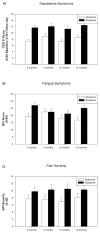Post-operative smoking status in lung and head and neck cancer patients: association with depressive symptomatology, pain, and fatigue
- PMID: 25257853
- PMCID: PMC4374041
- DOI: 10.1002/pon.3682
Post-operative smoking status in lung and head and neck cancer patients: association with depressive symptomatology, pain, and fatigue
Abstract
Objective: An estimated 35-50% of lung and head and neck cancer patients are smoking at diagnosis; most try to quit; however, a substantial proportion resumes smoking. As cancer treatments improve, attention to the effects of continued smoking on quality of life in the survivorship period is increasing. The current study examines if smoking abstinence following surgical treatment is associated with better quality of life.
Methods: Participants were 134 patients with head and neck or lung cancer who received surgical treatment. Smoking status and indices of quality of life (depressive symptoms, fatigue, and pain) were assessed at the time of surgery (baseline) and at 2, 4, 6, and 12 months post-surgery. Analyses were performed using a generalized estimating equations approach. A series of models examined the correlation between smoking status and post-surgery quality of life while adjusting for demographics, clinical variables, and baseline smoking status and quality of life.
Results: Continuous post-surgery abstinence was associated with lower levels of depressive symptoms and fatigue; however, the relationship with fatigue became nonsignificant after adjusting for baseline fatigue and income. There was no significant relationship observed between smoking status and pain.
Conclusions: Findings add to a growing literature showing that smoking cessation is not associated with detrimental effects on quality of life and may have beneficial effects, particularly with regard to depressive symptoms. Such information can be used to motivate smoking cessation and continued abstinence among cancer patients and increase provider comfort in recommending cessation.
Keywords: head and neck cancer; lung cancer; quality of life; tobacco use.
Copyright © 2014 John Wiley & Sons, Ltd.
Figures
References
-
- USDHHS. The Health Consequences of Smoking: A Report of the Surgeon General. U.S. Department of Health and Human Services, Centers for Disease Control and Prevention, National Center for Chronic Disease Prevention and Health Promotion, Office on Smoking and Health; 2004. Contract.
-
- Cox LS, Africano NL, Tercyak KP, Taylor KL. Nicotine dependence treatment for patients with cancer. Cancer. 2003;98:632–44. - PubMed
-
- Gritz ER, Schacherer C, Koehly L, Nielsen IR, Abemayor E. Smoking withdrawal and relapse in head and neck cancer patients. Head Neck. 1999;21:420–7. - PubMed
-
- Walker MS, Larsen RJ, Zona DM, Govindan R, Fisher EB. Smoking urges and relapse among lung cancer patients: findings from a preliminary retrospective study. Prev Med. 2004;39:449–57. - PubMed
Publication types
MeSH terms
Grants and funding
LinkOut - more resources
Full Text Sources
Other Literature Sources
Medical
Research Materials


